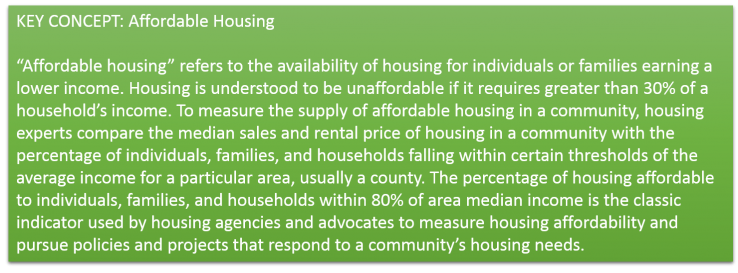On February 25, the NEOSCC Board will be voting on the the Vibrant NEO 2040 Vision, Framework and Action Products. Everyday over the next 5 weeks, we will be sharing an “Initiative A Day” so you can gain a better understanding of the vision and framework! If you would like to read all of the Initiatives, you can download them here Vibrant NEO Recommendation and Initiatives .
Show your support for Vibrant NEO 2040 by adding your name to our Champions of Vibrant NEO 2040 list here!
Initiative 4.3: Offer financial incentives to developers that incorporate affordable housing units into their projects and implement inclusionary zoning in markets with widespread affordability gaps.
WHAT THIS MEANS. Housing affordability is an issue that every community faces regardless of its location in a region. Age and value of homes, distribution of housing by tenure (e.g. apartments), employment, and income levels are factors in determining affordability. All of these factors are present in the housing issues facing Northeast Ohio communities. In legacy cities, the affordable housing problem centers on an oversupply of older single-family housing relative to new construction, which tends to be expensive condominiums and apartments beyond the financial reach of working families. In suburban communities, affordability problems present through a monoculture of housing types with insufficient range of tenure models; and in rural communities, affordability may be related to a net undersupply of all housing types.
Local jurisdictions, public housing agencies, and housing organizations are finding innovative ways to incentivize developers to “set aside” units at affordable price and rent points in their projects. These incentives can involve direct cash subsidies, though typically manifest as tax credits or tax-increment financing. Federal programs such as New Market Tax Credits and Low Income Tax Credits are popular incentives for encouraging housing affordability; local governments can also utilize state resources to offset project financing gaps, including grants and loans from the Ohio Housing Finance Agency.
Other valuable offset strategies that don’t impact local government finances but do have monetary value to developers include:
+ Density bonuses – grants developers the ability to exceed density limits specified in zoning without acquiring additional land;
+ Unit size reductions – permits reasonable reductions in area of affordable units relative to market-rate units;
+ Required parking reductions – grants developers the ability to build fewer parking units based on proximity to fixed-route transit stations and high-frequency bus service;
+ Design flexibility – grants flexibility in design review standards;
+ Fee waivers – reduces developer costs by waiving certain permit or infrastructure fees (such as sewer connections); and
+ Fee deferral – allows developer to defer fee payments until development is fully occupied.
(citation: Policy Link, http://www.policylink.org/site/c.lkIXLbMNJrE/b.5137031/k.8659/How_to_Use_It.htm)
Some municipalities may wish to consider formalizing affordability into their zoning. This would be best suited for municipalities with substantial investments in public transit, or districts that function as major regional and community amenities. Such practices, labeled “inclusionary zoning,” ensure that a percentage of housing units remain affordable to individuals or families earning less than 80% of area median income.
Preservation of housing affordability is a major determinant of regional livability. The Analysis of Impediments to Fair Housing Choice conducted as part of Vibrant NEO 2040, available in the “Technical Appendix”, provides a snapshot of the region’s housing affordability issues as well as a road map for rectifying them. Northeast Ohio communities must consider the findings of the analysis carefully, and marshal resources to fill any affordability gaps. Ensuring affordable and accessible communities of choice is essential to maintaining Northeast Ohio’s economic competitiveness as well as the fiscal solvency of all of its communities.
GETTING IT DONE. As in 4.1 and 4.2, this initiative must be led by local jurisdictions, including municipalities, townships, and counties. Regional planning entities such as MPOs and COGs can play a more active role in this initiative, however, especially in places where major regional transportation investments are being made, such as regional centers and transit corridors. Regional centers and transit corridors are ideal locations for affordable, workforce-oriented housing; municipalities in which such centers and corridors are located should take action to ensure that new housing development responding to future transit investment can accommodate individuals and families of all income levels.
| Lead | Public Housing Authorities; Municipalities, Townships, Counties; Metropolitan Planning Organizations |
| Target Community | Strategic investment areas, asset risk areas, cost risk areas |
| Implementation Complexity | Moderate |
These recommendations, initiatives, and products, are not one-size-fits all and some aspects of the initiatives won’t be applicable everywhere in the 12-county region. The Vibrant NEO 2040 Vision, Framework and Products are intended inspire and guide decision-making at the Metropolitan Planning Organization (MPO), Council of Government, and local levels to ensure that land use, transportation, and environmental considerations are simultaneously addressed by their processes. Ultimately, the implementation of Vibrant NEO 2040 is up to Northeast Ohio’s communities and residents. But regardless of the applicability of each initiative to any particular part of the region, the goal for each community within the Vision is the same: stability, prosperity, and a high quality of life for all of its residents.

